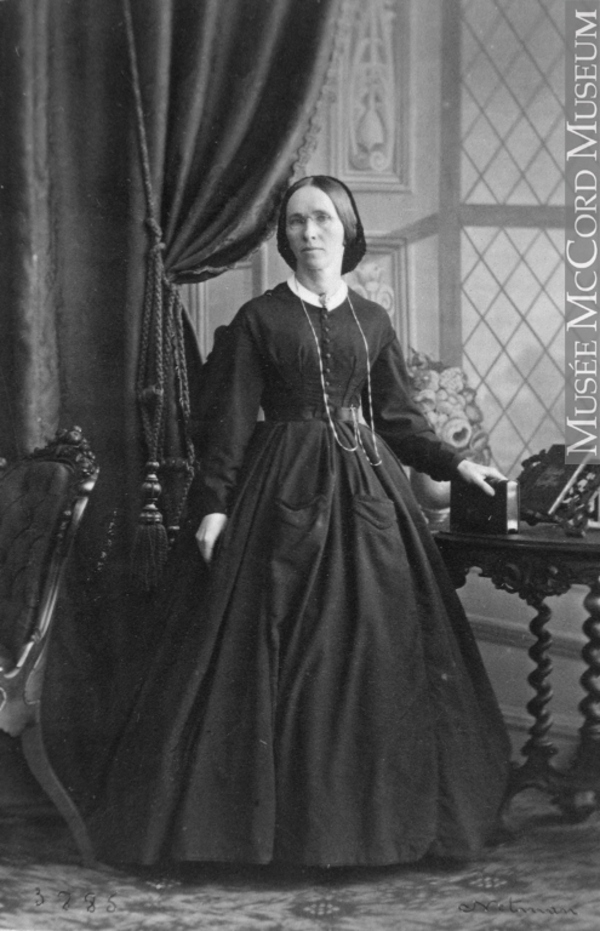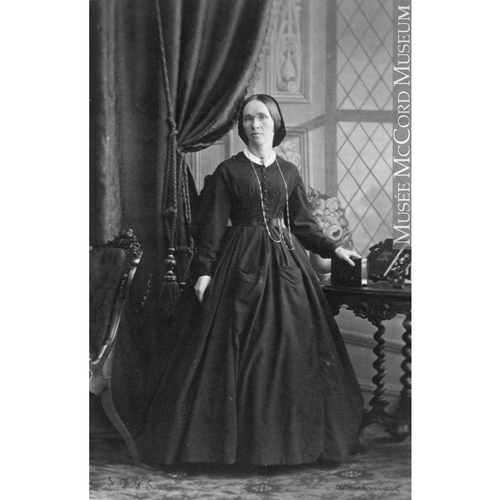
Source: Link
ROBERTSON, MARGARET MURRAY, school-teacher and novelist; baptized 22 April 1823 in Stuartfield, Scotland, daughter of the Reverend James Robertson, Congregational minister, and Elizabeth Murray; d. unmarried 14 Feb. 1897 in Montreal.
After her mother’s death Margaret Murray Robertson emigrated with her family to Derby, Vt, in 1832. Four years later they moved to Sherbrooke, Lower Canada, where James Robertson was the Congregational minister for 25 years, until his death in 1861. Three of Margaret brothers, Andrew*, George R., and William Wilcox, became distinguished Montreal lawyers. Another, Joseph Gibb, was a businessman and for many years provincial treasurer. A sister, Mary, married the Presbyterian minister of Glengarry, Ont., Daniel Gordon.
In 1847–48 Margaret attended Mount Holyoke Female Seminary in South Hadley, Mass., an institution renowned for its intellectual standards and the religious basis of its curriculum. She then taught until 1865 at Sherbrooke Academy, a girls’ school. She loved teaching, and in 1864, when she was 41, her “essay on common school education” won a prize offered by Alexander Tilloch Galt to teachers of the Eastern Townships; the essay was published in the Sherbrooke Gazette and Eastern Townships Advertiser on 14 and 21 Jan. 1865. In it she asserted that, beyond imparting knowledge, “to develop and strengthen the mental powers, to teach a child to observe, to think, to reason, must ever be the first consideration in any system of education.” She went on to argue that more important even than teaching this mental discipline was “moral training,” for “knowledge unguided and unrestrained by high moral principle, is a power for evil.” Because the moral standard was God-given, moral training to be successful had to be religious and “emphatically Christian,” but not sectarian. If government was to achieve a higher standard of education outside the major cities and towns, she maintained, it would have to raise the level of knowledge for licensed teachers, ensure their moral fitness, provide them with financial conditions that would safeguard stability and professionalism (which meant an end to the system of “boarding round” common in rural areas), restrict the curriculum to basic courses (including Scripture history and Canadian and British history), and supply uniform Canadian-produced textbooks as good as those which were then procured from the United States and Britain.
Ironically, it was perhaps the success of this article that induced Robertson to give up formal teaching for a career in writing; between 1865 and 1890 she published at least 14 novels. However, the themes of her writing reflect so faithfully her principal preoccupation as a teacher – the development of an informed, strong, and moral youth, particularly among females – that she was clearly exercising her profession of educator in another mode, one which would permit her to reach a vastly greater number of young people. A concern with Christianity is always in evidence. Her fictitious families read the Bible together and attend church services regularly. The protagonists are often members of a clergyman’s family or become converted to a true or stronger faith. In the more didactic novels, lengthy sermon-like speeches of spiritual encouragement or explanation are worked into the conversations. The author’s Christianity is identifiably Protestant, but her Protestantism is without Calvinist rigidity. Rather it is a forgiving religion that emphasizes love and understanding and offers comfort in times of trouble. In writing thus, Robertson was contributing to a trend encouraged by evangelical publishers such as the Religious Tract Society (London) and the American Sunday School Union (Philadelphia), which published some of her novels. Eventually, however, her works were published mostly by the secular houses of Hodder and Stoughton (London) and Thomas Nelson (New York); these firms responded to the growing popularity of a fiction that both blended the softer dogmas of a loving Christianity with romantic plots and was acceptable even to severe Christians, who until then had rejected the novel.
The principal agents of Robertson’s Christianity are female, girls and women being the main protagonists of her novels; here is no Mosaic patriarchy. Her plots are centred on the home and the family, in which women provide love, strength, and unity. Indirectly Robertson treats the family as a microcosm of society, suggesting that a society guided by women would function on the basis of charity, cooperation, and mutual respect, in contrast to the existing male-dominated world of authority, exploitation, and materialism. Robertson is no revolutionary, however, and is generally conventional in outlining the roles and duties of female characters. Yet her women are lively rather than prissy, intelligent rather than self-righteous, imaginative rather than prudish, courageous rather than weak. In Shenac, the story of a Highland family in Canada (Philadelphia, [1868]), Shenac rather than one of her brothers becomes the leader when, on their father’s death, the children must run the family farm until the eldest son returns. In By a way she knew not; story of Allison Bain (New York, 1887), the heroine runs away from a marriage of convenience and is eventually liberated by her husband’s death, but only after discovering that she could not find happiness until she had done her duty by him. Unmarried herself, Robertson supported single women in her novels: in The two Miss Jean Dawsons (New York, 1880), for example, Jean Dawson becomes a successful businesswoman while retaining her feminine qualities.
For the most part Robertson clearly defines class roles. Scottish dialect is broader among the lower classes and rarely evident in the speech of ministers, teachers, or others of the educated class. Her protagonists display little desire to alter their status, however much their economic situation might change. Indeed, material gain as an ambition is to be disdained in Robertson’s world, but honesty and hard work invariably bring material and spiritual prosperity. Alcoholism among the working class being a major concern of religious writers and, later, of female activist groups, it constitutes a significant theme in Robertson’s writings where it is treated implicitly as a disease, the remedy for which lies in procedures practised today by Alcoholics Anonymous.
Robertson’s work probably draws on her family experience for much of its didactic message. Often the mother or father dies – sometimes both die – and the children must take on the responsibilities of dead parents. They mature through hard work, suffering, and responsibility, bolstered by family love and solidarity and by religious faith. As well, all of Robertson’s works are set in areas familiar to her: Aberdeenshire in Scotland, New England, the Eastern Townships, Glengarry County, and Montreal, where she was living by 1871. Shenac, set in the early Upper Canadian Scottish settlement of Glengarry, portrays the harsh life of the settlers and describes the seasonal farm activities, the closeness of family life, the helpfulness of neighbours, and the importance of religion, all of which characterized life in the region. In it, as in By a way she knew not, Robertson uses local colour – customs, dialect, and descriptive details – effectively. It has been suggested that she influenced the writing of her nephew Charles William Gordon* (Ralph Connor), whose The man from Glengarry: a tale of the Ottawa (Toronto, 1901) and Glengarry school days: a story of early days in Glengarry (Chicago, 1902) remain well known.
By drawing on her personal experiences Robertson gave her novels a vividness and sense of reality that help to carry their didactic charge. Like a good teacher, she is conscious that her lessons must be attractive, and she effectually lightens her treatment of religion and morals with the leaven of romance and sentiment. At the same time, however, she shifted the sentimental romance of her time into a more realistic, domestic mode. The romance is usually found with a childhood friend or a recently arrived teacher or clergyman. The sentiment often includes at least one deathbed scene. In the very successful Christie Redfern’s troubles (London, 1866), Christie dies happy, having changed from a bitter, complaining girl to a loving young woman, guided by the devoted attention of an older sister. Shenac, By a way she knew not, and The bairns; or Janet’s love and service (London, 1870) were among Robertson’s most popular novels. Many of her works were clearly designed for youthful readers, but these three appealed to a more mature audience as well.
Meeting the demands of her time for didacticism and moralism while entertaining her readers with memorable characters and vivid descriptions of place, Robertson was widely read and frequently reprinted in Britain, the United States, and Canada. Although her brothers had distinguished careers as lawyers and politicians, she, through her writings, was the more influential.
According to a contemporary, Robertson was a brilliant conversationalist, intelligent and highly regarded by her acquaintances. She was neither demonstrative nor emotional. Although, as a teacher, she was devoted to her pupils, she never called a student by a pet name; instead, she looked to the intellect. Correspondingly, her students revered rather than loved her. Except when writing, she knitted constantly – “not fancy knitting, but plain, useful stockings,” which she gave to poor boys. In one winter she knitted 96 pairs. To the end she retained a strong modesty about her novels despite their popularity, and she lived so quietly in Montreal that her death and private funeral, in February 1897, nearly passed unnoticed.
Margaret Murray Robertson is the author of An essay on common school education; the Galt prize essay (Sherbrooke, Que., 1865) and of some 14 novels, all listed in Watters, Checklist of Canadian literature (1972).
ANQ-M, CE1-215, 16 févr. 1897. GRO (Edinburgh), Stuartfield, reg. of births and baptisms, 22 April 1823. Montreal Daily Witness, 15, 20 Feb. 1897. Sherbrooke Gazette and Eastern Townships Advertiser (Sherbrooke), 17 Dec. 1864; 14, 21 Jan. 1865. Borthwick, Hist. and biog. gazetteer. Morgan, Bibliotheca canadensis. British Library general catalogue. National union catalog. R. [C.] MacGillivray and Ewan Ross, A history of Glengarry (Belleville, Ont., 1979). J. G. Robertson, Sketch of the formation of the Congregational church at Sherbrooke and Lennoxville (Sherbrooke, 1890). R. [C.] MacGillivray, “Novelists and the Glengarry pioneer,” OH, 65 (1973): 61–68.
Cite This Article
Lorraine McMullen, “ROBERTSON, MARGARET MURRAY,” in Dictionary of Canadian Biography, vol. 12, University of Toronto/Université Laval, 2003–, accessed April 29, 2025, https://www.biographi.ca/en/bio/robertson_margaret_murray_12E.html.
The citation above shows the format for footnotes and endnotes according to the Chicago manual of style (16th edition). Information to be used in other citation formats:
| Permalink: | https://www.biographi.ca/en/bio/robertson_margaret_murray_12E.html |
| Author of Article: | Lorraine McMullen |
| Title of Article: | ROBERTSON, MARGARET MURRAY |
| Publication Name: | Dictionary of Canadian Biography, vol. 12 |
| Publisher: | University of Toronto/Université Laval |
| Year of revision: | 1990 |
| Access Date: | April 29, 2025 |



